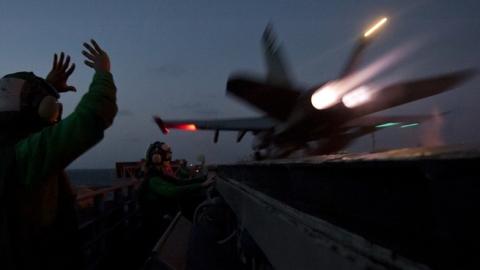The year past was an important one for the Navy and its power projection centerpiece, the large, nuclear-powered aircraft carrier. Dr. Jerry Hendrix and I got things off to a rollicking start in January with an old-school debate about carriers at the Naval Academy, my think-tank released a study that makes the case for the necessity of the carrier in the high end fight--a view 180 degrees out of the prevailing narrative of China's A2AD arsenal rendering the carrier obsolete, and Hendrix rounded out the year with a superb study of how the carrier's "retreat from range" had indeed fed the narrative just referenced.
Along the way, the Senate Armed Services Committee led by its Chairman Senator John McCain (R-AZ) performed a necessary and critical oversight role in relentlessly urging the Navy to reduce the cost of the carrier and improve its acquisition performance. Additionally, Senator McCain sent the Navy and other organizations off to evaluate alternative carrier designs, because he asserts, "we simply cannot afford to pay $12.9B for a single ship." Those evaluations will hit the street in 2016, which is incidentally the year the nation's newest carrier USS GERALD R FORD (CVN 78) is due to be commissioned.
Having so publicly defended the aircraft carrier in 2015, I begin 2016 by asserting that I am not an aircraft carrier advocate, just as I am not a destroyer advocate, or a maritime patrol aircraft advocate (both of which I will defend with the same tenacity as I do the CVN). No, I am a Seapower advocate, and because I continue to cling to the increasingly outdated notion that our Navy and Marine Corps perform the equally strategically important functions of preventing AND conducting war, I will continue to defend the aircraft carrier's centrality in a balanced fleet capable of performing both of these functions.
So to get the year off on the right foot, a few thoughts to baseline what is likely to be another year of churn on this topic.
1. It's the Air Wing, Stupid. While I disagree with Senator McCain's pronouncement that we "...cannot afford to pay $12.9B for a single ship" (see below), the plain, ugly truth is that if the FORD Class cost $9B, its utility in deterring the wars we must not fight (and the wars that we therefore cannot lose) would not be any more apparent. To put it another way, whether we spend $12.9B or $9B or $5B--the money will be ill-allocated unless the main battery of the carrier evolves to meet the threat. By that, I mean that the air wing must evolve (as it has consistently for seven decades) to provide long range stealthy strike, sea control, ISR, and organic refueling, if even the first dollar allocated in carrier construction is to be worthwhile. Jerry Hendrix report above, and the one we did at Hudson (also cited) make this point forcefully. Without this evolution (and a timely evolution at that), the carrier will indeed become what its critics have predicted for decades, an expensive anachronism. And as the Hudson study asserted, the carrier--with an upgraded air wing--is likely to provide essential and unique combat capability in high end scenarios under consideration. But only if the air wing evolves.
2. What Should a Carrier Cost? Many critics of the FORD Class take aim squarely at its cost, most recently estimated by the Navy at $12.9B. My response to them is, what should it cost? What should a floating, nuclear-powered air base, that moves...at 40 plus knots....for fifty years...cost? Against what are you comparing it? No other bit of military kit is as complex or as useful as the aircraft carrier, and very few examples of military hardware last as long. Are we so unduly influenced by its acquisition cost that we lose the ability to adequately assess the long term return on investment? Also, since we buy a carrier once every five years, about a third of one percent of every dollar spent on defense in those five years are spent on CVN's. Are the above benefits not worth a third of a percent? We are entering a new era of great power contention, and the post-Cold War model of defense spending is insufficient. We need to begin building up to meet the challenges of this new competition, and while we must continue to do everything we can to drive excess cost out of acquisition programs, perspective and understanding of what is required to meet this challenge is necessary. Viewing an asset with the capability and flexibility of the CVN--even at its current cost--as "unaffordable" is simply inconsistent with the demands of the future.
3. You Can't Go Backward, You Won't Do Better, and Steel and Space are Cheap. Chairman McCain's direction to the Navy to go back to the drawing board and to study alternative carrier designs is a useful and necessary task, one that forces what is a characteristically hidebound organization to examine its presumptions and prove its assertions. Similar inquiries have been forced upon the Navy in the past, as the Hudson study above recounts. Each time, however, two consistent themes arise in the analysis. Bigger is better, and nuclear power is preferable to fossil fuels. Size and propulsion are directly related to the performance of the ship/air wing system, as measured by a diverse series of metrics including sortie generation, aircraft size accommodation, range, and mission diversity. Because steel and space are relatively cheap, the additional size gained in a larger carrier creates disproportionately large increases in performance. Put another way, if the Navy is presented with a design for an aircraft carrier that costs 2/3 of what the FORD costs AND can deliver 2/3 of its performance (or better)--it should consider buying it. You can substitute any ratio into the previous sentence, and my view would be the same. The trouble is, such a carrier does not appear to exist. If this nation simply wants to spend less on its aircraft carriers because it believes them to be too expensive, than our leaders need to step forward and declare that they are content with buying proportionally less capability. Some have suggested simply dropping back, retooling, and building NIMITZ class carriers again beginning in the 2020's. Such a path should be considered among the various options. My gut tells me that the cost of such a move, coupled with a decrease in ship/air wing performance that would occur, would be nonsensical in comparison to continuing to build FORD Class carriers and benefiting from the historic constant dollar decline in cost of ships in serial production.
**4. Competition For Hulls Would Be Nice, But It Is Not Going To Happen With Our Current Industrial Base.** Building large, complex surface ships is done at frightfully few places in the United States. Building large complex surface ships from which fixed wing aircraft can be launched and recovered is done at two places in the United States. Building large, complex nuclear-powered surface ships from which fixed wing aircraft can be launched and recovered is done at one place in the United States. While I take a backseat to no one in my support for the benefits of competition in free markets, I am unconvinced that any attempt to inject hull-based competition into the carrier program will have any impact on cost--except to increase it. If the United States decided that it needed additional shipbuilding capacity in order to produce a competed, conventionally powered aircraft carrier, it would almost certainly have to invest billions of dollars into capital improvements at an existing yard that isn't owned by the one company that owns both yards currently capable of doing so (Huntington Ingalls Industries at its Newport News, VA and Pascagoula, MS yards). The cost of capitalizing a second nuclear powered aircraft carrier building yard would be enormous. Putting aside the prohibitive costs of competing hulls, were we to push for a conventionally powered variant simply to reduce total costs, we run into the problems cited above in #3. To the extent that competition CAN be pushed back into the CVN program, it is going to largely reside in the Government Furnished Equipment (GFE) that the shipbuilder is provided with, and competition for these items demands that the horrible mistakes in early CVN 78 program management and oversight not be repeated. The 2002 decision to inject over a dozen unproven technology upgrades into the first hull (CVN 78) rather than across the first three, dealt this program early blows from which it is only now recovering. Congress must continue to hammer the Navy on the twin/related problems of immature designs and concurrency, while ensuring that as much competition is injected into the furnishing of mature capability.
5. The Burden is On the Critics to Show The Extensibility of Their Views. If someone were to come forward with a fleet architecture that either diminished or eliminated the importance of the CVN while maintaining the balance of conventional deterrence and warfighting that exists in the current fleet, I would walk away from the CVN in a heartbeat. But like the proportionally capable/cheaper aircraft carrier, such a fleet architecture does not currently exist. The perturbations from the current fleet architecture either diminish warfighting in order to plus up deterrence, or (as we see from the letter above from SECDEF to SECNAV) they diminish deterrence in order to plus up wafighting. I do not believe that the current fleet architecture is the ONLY one that could accomplish the required balance between conventional warfighting and deterrence. But in my view, any competing approach MUST demonstrate in some reasonable manner that it maintains such a balance, or that such a balance is no longer required or desired.
Ok, release the hounds. There are a few things to chew on as we all consider how to best contribute to the robust debate underway in our area of collective interest. Happy New Year.



















